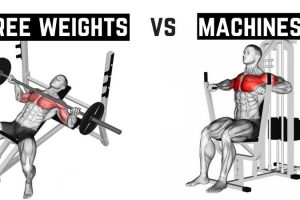This is probably one of the longest lasting debates. Which type of training is better: free weight training or machine training? When it comes to building more muscle, bodybuilders are always looking for even the tiniest details that they can improve their lean gains. In this spirit, all of us have had the chance to overhear steamy gym arguments over the best way to train.
So let’s end this argument once and for all, because this one is really about facts vs. myths. Here we go!
Why Strength Training
Just a quick reminder of the importance of weight training, which can be the most beneficial form of physical exercise for the most common goals of exercising: leanness, health, strength, power, endurance, aesthetics and athleticism.
So regardless of your age, gender, typical inclinations or specific goals are, you’d be wise to make some room for strength training in your fitness program.
Among many other things, strength training will help you improve:
- Body composition
- Blood glucose control
- Blood pressure
- Bone density
- Muscle tone
- Cardiorespiratory fitness and aerobic capacity
There are already dozens if not hundreds of studies which demonstrate the power of strength training to sculpt your body and strengthen your muscles, but also burn excess fat and improve cell health.
The Typical Argument
Any experienced bodybuilder will generally tell you that free weights are superior because they allow the trainee to activate more muscles through activation the core and groups of stabilizing muscles.
This, in turn, stimulates greater overall muscle growth. But if he’s being truly honest with you, he’d also tell you that machines, on the other hand, can be super useful when the trainee wants to isolate some muscle more precisely and then hammer it with all possible intensity.
The truth is that, as with anything else, both approaches have their sets of benefits and flaws. And if you learn how to use this to your advantage, it might help you unlock another step to your journey to a god-like physique!
Free Weights Are Not Always Best Choice
The best thing about free weights is that they’re inexpensive, easily portable but also highly effective. But, if you only train with them, you’d miss out on the great blessing of resistance machines: they allow you to entirely focus on targeting a specific muscle.
However, they are expensive to have at home, they take a lot of space, and they may provide a lousy workout in a public crowded gym, especially if you rely too much on machine-based movements.
To break the ice, here are three great machine-based exercises that might be superior to their free weight counterparts:
1. Chest Supported Machine Rows

Recommended Reps: 4 x 10-12
- Get on a chest supported row machine and find the right position from which you can pull the weight in a relatively comfortable motion.
- Keeping your back arched and the chest and lower back stuck out, squeeze your shoulder blades and then follow the movement with your arms.
- Slowly lower the weight back to the starting position and relax your lats, traps and rhombs.
2. Pec Deck Fly Machine

Throw a peck deck fly machine exercise at the end of your heavy duty chest routine, as this will allow you to isolate the pectoralis muscle without putting undue stress on the rotator cuff.
Recommended Reps: 3 x 12-15
To get it right, adjust the seat on a pec deck fly machine so that your torso is straight. As you keep your shoulders pinned back, squeeze the weight through the middle of the chest, then lower the weight back while keeping the pecs tensed at all times.
3. Seated Shoulder Press

To get the most out of this move, make sure you keep your form flawless. Your anterior delts will be “thankful”.
Recommended Reps: 4 x 8-10
- Set up the machine so that your starting hand position is at about chin level.
- Press the weight up, while keeping your traps down. Make sure you don’t go full lockout at the top. Slowly lower the weight down at eye level and press back up.
Free Weights Vs. Machines: The Conclusion
Now that it’s more clear that both types of training offer unique advantages, let us break the bad news:
- If you’re primarily using free weights, once in a while your core muscles will quit the game before the primarily muscle itself is fully worked to the desired maximum.
- Machine weights, then, present another problem: they are not a one-size-fits-all, so they can be uncomfortable, useless or downright dangerous for some body types.
- Machines are are also fixed to an axis that will only allow you to move in one or two planes.
Also, don’t forget that free weights allow you to use your body in all three dimensions, or planes of motion: forward-backward, horizontally and vertically. So it’s only natural that this training style engages more muscles, especially strengthening the often neglected stabilizing muscles in the core.
So ultimately, the choice is yours. But if you are very well aware of the characteristics and big benefits vs. flaws of each option, you have increased chances of making a great decision.
Intensity Is More Important Than Type of Weight
You may eventually opt for free weights, resistance machines, resistance bands, or bodyweight exercises… that’s really unimportant in the bigger picture of things, actually. However, if you make sure that every exercise you perform is done in a super-slow style or in another intensity-boosting way, you are guaranteed to get good results with any training style.
Just focus on working the target muscle or muscle group with optimal intensity and make sure you reach a high level of muscle fatigue. A day or two of proper rest, recovery and diet will do the rest.

